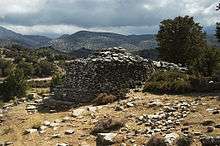Mitato

Mitato (Greek: Μιτάτο, archaic form: μιτᾶτον or μητᾶτον, from Latin: metor, "to measure off/to pitch camp") is a term meaning "shelter" or "lodging" in Greek.
Appearing in the 6th century, during the Byzantine period it referred to an inn or trading house for foreign merchants, akin to a caravanserai. By extension, it could also refer to the legal obligation of a private citizen to billet state officials or soldiers. Alternatively, in the 10th century, Constantine Porphyrogenitus uses the term to refer to state-run ranches in Anatolia.[1]
In modern Greece, and especially on the mountains of Crete, a mitato (in the plural mitata) is a hut built from locally gathered stones to provide shelter to shepherds, and is used also for cheese-making. Mount Ida (also called Mount Psiloritis) in central Crete is particularly rich in flat stones suitable for dry stone construction.[2][3][4]
References
- ↑ Oxford Dictionary of Byzantium, p. 1385.
- ↑ Antonis Plymakis, Koúmoi-Mitáta kai Boskoi sta Leuká Ori kai Psiloriti ("Shepherd's huts and shepherds in the Lefka Ori and the Psiloritis"), Chania, 2008, 630 p.
- ↑ Harriet Blitzer, Pastoral Life in the Mountains of Crete. An Ethnoarchaelogical Perspective, in Expedition, vol. 32, No 3, 1990, pp. 34-41 (on the shepherd's huts of Eastern Crete.
- ↑ Sabine Ivanovas, Where Zeus Became a Man (with Cretan Shepherds), Efsthiadis Group Editions, 2000, 183 p. (Life in the corbelled dry stone huts of central Crete).
External links
- (French) Cabanes d'estive (mitata) des environs d'Anogia en Crète centrale (Grèce) (Summer shepherding huts (mitata) in the vicinity of Anogia in central Crete, Greece)
